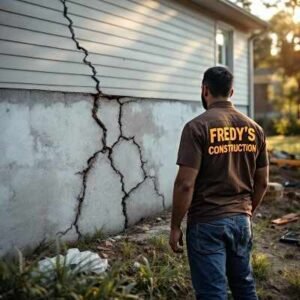What Every Cullman Homeowner Needs to Know in 2025
If you’ve found a crack in your concrete slab, you’re not alone. Slab foundations are common, and yes, cracks can and do appear over time. A slab foundation is a flat concrete base poured directly on the ground, supporting your entire house from beneath.
For homeowners, seeing cracks in a slab foundation can cause real worry. They make us question what’s happening underfoot and what it might mean for the safety of our biggest investment. The good news is, not every crack is a crisis, but it’s important to know which ones demand attention.
In this post, we’ll break down why slab foundations crack, what those cracks can mean, and when it’s time to take action. By the end, you’ll know how to spot the warning signs and what steps to take to protect your home for years to come. Now that is some great information that we at Fredy’s Construction Services are proud to share with our clients and potential clients.
Why Slab Foundations Crack
When we ask “Do slab foundations crack?”, we really want to know what’s happening under our homes and why. Not every crack means something is wrong, but it helps to understand the biggest reasons cracks show up. Let’s break down the most common causes so you can spot the signs early and react with confidence.
Natural Settling and Shrinkage
Concrete changes as it dries. As the water in fresh concrete evaporates, the slab actually shrinks a little bit. Most homes also naturally settle over time. As the ground compacts and shifts under your house, tiny cracks may appear in the slab.
-
-
Hairline cracks (less than 1/8 inch wide) are usually normal and don’t point to serious trouble. They often show up within the first year or two after construction as part of settling and drying.
-
-
-
Wider or uneven cracks can signal bigger issues, especially if they keep getting worse or if one side of the crack is higher than the other.
-
If you notice a few small, straight cracks and no other signs of movement, you’re likely seeing normal settling. If the gaps get wider or you see your floors sloping, call a Cullman pro right away.
Soil and Moisture Problems
What’s under your home matters just as much as what’s above it. Many slab cracks happen because of changes in the soil below.
-
-
Soil swells when it gets wet and shrinks when it dries out, especially in areas with clay soil. This heaving and shrinking puts stress on the slab from below.
-
-
-
Droughts and heavy rain each have their own impact. Dry spells can shrink soil away from the edges of your slab, while sudden rain can swell pockets of soil and press against the concrete.
-
Clay soils are the riskiest. They move more as moisture levels change, making homes on clay more likely to crack. Watch for these warning signs:
-
-
Cracks that zigzag across floors
-
-
-
Gaps along the edges where the slab meets walls
-
-
-
Doors and windows that stick or don’t close right
-
When these signs appear along with foundation cracks, soil is probably the cause.
Weather and Temperature Changes
Concrete doesn’t like sudden, extreme weather swings. When temps heat up, slabs expand. In cold snaps, they contract. These changes make the slab flex and, over time, lead to cracking.
-
-
In hot climates, cracks can follow after several weeks of blazing sun.
-
-
-
In freezing areas, repeated cycles of thawing and refreezing cause the most trouble.
-
Even in places with mild weather, sudden storms or quick temperature drops can make old minor cracks get worse. Those changes stress the slab, especially right at weak points around doors, windows, or plumbing lines.
Knowing how weather and home design interact can help you spot patterns and take action sooner if needed. Not all cracks are a crisis, but paying attention keeps small problems from turning into major headaches.
When Slab Cracks Become a Problem
Not every crack in a slab foundation is a reason to panic, but ignoring the wrong type can lead to bigger headaches and expensive repairs later. Knowing the difference between harmless blemishes and serious signs is the first step to keeping your home solid and safe. We want homeowners to feel confident when they spot a crack, so let’s tackle how to tell cosmetic from structural—and which warning signs mean it’s time for fast action.
Recognizing Cosmetic vs. Structural Cracks
Cosmetic cracks are the tiny, hairline fissures that happen as concrete cures and settles. These often show up as thin, straight lines and usually measure less than 1/8 inch wide. They’re common and almost always harmless, especially in the first year after building or after major temperature swings.
On the other hand, structural cracks are like red flags waving at you from your foundation. These tend to be wider—think bigger than 1/4 inch—or run in worrisome directions, like diagonally or horizontally. Cracks that change width along their length or seem to move upward at one end could mean part of your slab is sinking faster than the rest.
Here’s a quick rundown:
-
-
Cosmetic cracks: Thin, straight, less than 1/8 inch wide, usually stable over time
-
-
-
Structural cracks: Wider than 1/4 inch, zigzag, diagonal, or horizontal, may widen or shift
-
Top Warning Signs You Should Never Ignore
It’s not just the crack itself that spells trouble. Several other clues combine with cracks to point us toward real structural risk. Stay alert if you notice any of these:
-
-
Floors that slope or feel uneven (like a marble rolling across the room)
-
-
-
Doors and windows that suddenly stick or won’t shut right
-
-
-
Gaps at the top of walls or where walls meet the floor
-
-
-
Cracks that grow, shift, or change direction over a few months
-
-
-
Water seeping in through cracks, leaving stains or musty smells
-
An easy way to track cracks is to mark their ends with a pencil and check every few weeks. If they get longer or start to branch out, don’t wait—these changes signal something under your slab might be moving.
When Fast Action Is Your Best Friend
If you spot a wide, jagged, or expanding crack—especially if it’s paired with sticky doors or funny smells from damp concrete—it’s time to bring in an expert. Wide cracks and uneven floors tell us that the ground under your home might be shifting or settling. Ignoring these invites bigger repairs, and let’s be honest, higher costs.
The bottom line: no two slabs crack exactly the same way, but the signs above should always get our attention. If you find yourself facing anything outside typical hairline cracks, getting a professional inspection is the quickest way to peace of mind and a safer home.
Stay tuned, because knowing when slab foundations crack is one thing—understanding how to fix them is the next step to protecting your biggest investment.
What Can Cullman Homeowners Do About Slab Foundation Cracks?
Learning what to do when you spot cracks in your slab foundation is empowering. Many of us spot a hairline in the garage or a jagged line on the porch and instantly worry. The good news is, most cracks are common and manageable. Paying attention, following a smart action plan, and knowing when to call for help will keep our home strong and safe.
Commit to Regular Foundation Inspections
Cracks can appear at any time, but watching for changes is the first line of defense. We recommend making slab checks part of our home maintenance routine, especially after heavy rain, droughts, or seasonal change. Keep a record of when and where you find new cracks. Measuring and noting their size helps us catch problems before they grow.
How to track foundation cracks:
-
-
Take photos with your phone (add a coin for scale)
-
-
-
Use a marker to note the crack’s ends, checking monthly
-
-
-
Look out for new cracks after major weather
-
Quick checks a few times a year give us peace of mind and help us act fast if new damage appears.
Basic Foundation Maintenance Tips
Prevention is always easier than big repairs. Here are practical steps we can take as homeowners to keep slab cracks in check:
-
-
Direct water away from the foundation: Maintain gutters, add downspout extenders, and check that water does not pool near the house.
-
-
-
Grade the soil so it slopes away from the home, not toward it.
-
-
-
Water the soil during droughts: If you live in a dry climate with clay soil, a soaker hose can keep moisture steady and prevent soil from shrinking under the slab.
-
-
-
Keep trees and shrubs a safe distance away (at least 5 feet for shrubs, 20 feet for large trees) to avoid roots disturbing the soil near the foundation.
-
-
-
Avoid piling mulch or garden beds right against the slab.
-
These fixes might seem small, but together they prevent water from undermining your foundation and keep the soil environment stable.
When to Attempt DIY vs. Call a Professional
Deciding if you should fix a crack or call an expert starts with knowing the type and size of the crack:
Crack Type |
Width |
Action |
Hairline |
< 1/8 inch |
Monitor, DIY repair |
Cosmetic |
1/8 to 1/4 in |
Monitor closely, consider DIY |
StructuralExpanding |
> 1/4 inch |
Pro help |
For tiny, stable cracks, simple patch kits or epoxy fillers from the hardware store can help seal things up. Stay cautious—bigger, widening, or uneven cracks usually point to structural movement and need an expert’s eyes.
Red flags that call for pro help:
-
-
Cracks wider than 1/4 inch
-
-
-
Cracks zigzagging or wider at one end
-
-
-
Floors that feel uneven or doors that stick
-
-
-
Water seeping up through cracks
-
When you see any of these, don’t wait. Reach out to a trusted foundation specialist. Fast action can truly save thousands of dollars in repairs and keep our homes safer.
By watching, maintaining, and acting at the right time, we can take charge of foundation cracks long before they threaten our home’s safety. And if you ever feel unsure, remember that a quick call to a local pro could be the best investment you make all year.
Conclusion

